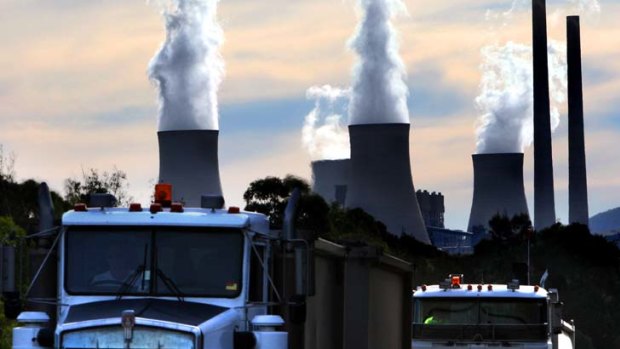This was published 12 years ago
Power generators top list of carbon emitters to pay tax
By David Wroe
NSW'S biggest power generator could pay nearly half a billion dollars a year under the carbon tax, according to government figures released yesterday - a payment that is likely to flow through to electricity costs.
The state-owned power giant Macquarie Generation tops the list of big carbon emitters.

Big polluter ... Bayswater Power Station.Credit: Rob Homer
The list, published yesterday under the National Greenhouse and Energy Reporting Act, is certain to renew the energy sector's ire towards the government's carbon package.
It provides a snapshot of which companies will bear the brunt of the tax, starting July 1, and is dominated by big coal-fired power generators.
BlueScope Steel and Alcoa also make the list, though both will be heavily compensated. Mining firms BHP Billiton and Rio Tinto get some assistance.
Macquarie, which owns and operates Liddell Power Station and Bayswater Power Station in the upper Hunter Valley and produces about 40 per cent of the state's power, pumped out more than 20 million tonnes of carbon dioxide in the 2010-11 financial year, according to the figures. At $23 a tonne, that will cost the generator about $460 million a year, most of which will be passed on to customers but some of which the company will have to absorb.
The Macquarie chief executive, Russell Skelton, told the Herald last night that the cost would hit the company hard with no compensation. ''You can very easily see us becoming unprofitable,'' he said.
Electricity generators dominate the list of companies that will pay the tax.
A spokesman for the Climate Change Minister, Greg Combet, said that electricity generation was one of the most emissions-intensive sectors of the economy and needed to transform. ''It is essential that Australia begins to transform this sector so our economy remains competitive as the world moves to tackle climate change by reducing carbon emissions,'' he said.
The government was giving the most emissions-intensive generators $5.5 billion in assistance to help transform the sector and ensure energy supply stability and security.
But Mr Skelton said this would go overwhelmingly to brown coal generators in Victoria.
''They understand that we're going to be damaged but there was reluctance to compensate generators like us in NSW and Queensland and I'd say it'd be fair comment to say we were never really sure why not.''
The government's compensation scheme for electricity generators applies to the more emissions-intensive end of the sector, which is generally the dirtier brown coal burned in Victoria's Latrobe Valley.
Matthew Warren, the chief executive of the Energy Supply Association of Australia, said the total emissions figures put out by the government yesterday masked the most pressing issue for energy firms - that forward-dated carbon permits needed to hedge carbon costs would have to be paid for upfront. He said this could cost the sector hundreds of millions of dollars.
''That is hundreds of millions of dollars in costs to energy providers for no good reason other than the federal government's hunger for cash,'' he said. ''Paying for permits up front is all about the federal budget bottom line and nothing to do with reducing emissions.''
Yesterday's news came as Virgin Australia announced it would charge passengers as much as $6 extra for domestic flights to cover the cost of the carbon-pricing scheme.
From July, passengers will pay $1.50 extra for a flight of up to 900 kilometres, $3 for up to 2000 kilometres and $6 for longer domestic flights. The airline estimates the total cost of the carbon tax at between $45 million and $50 million next financial year.
with Matt O'Sullivan